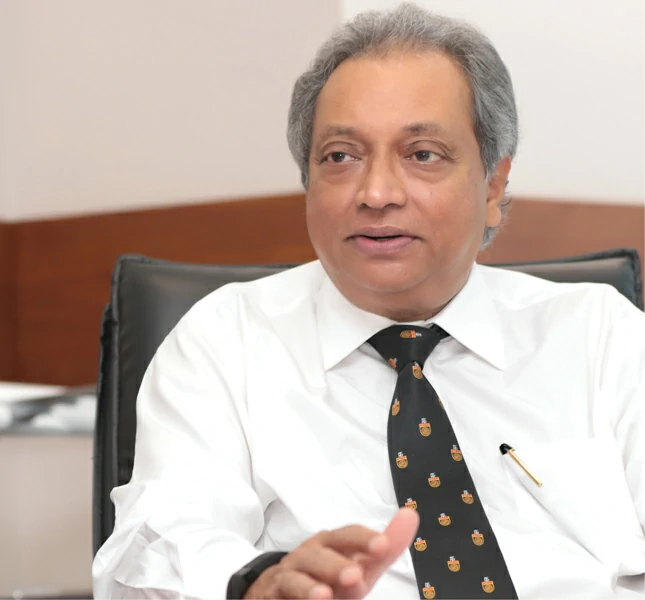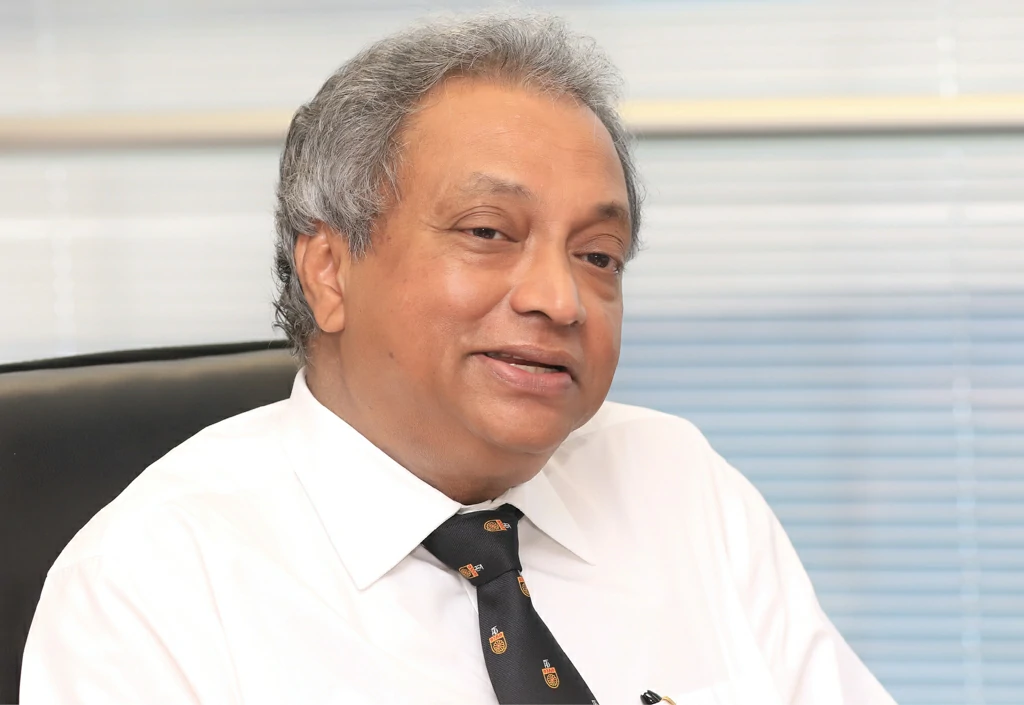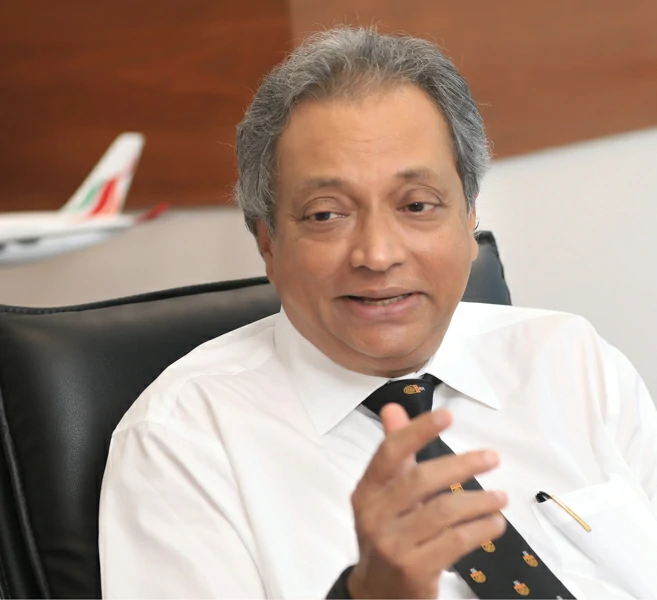
It is a time of change for the national carrier SriLankan Airlines. Ajith Dias, Chairman of SriLankan Airlines speaks about the progress made in the financial year where losses have been minimised through restructuring and implementing new processes and systems. While details of the private public partnership that is to be formed to make the Airline a more viable entity is still in progress, Chairman Dias explains that this will provide positive results for SriLankan where international expertise will take the Airline to the next level.
By Udeshi Amarasinghe. Assisted by Yomal Senarath-Yapa
Photography Mahesh Bandara and Menaka Aravinda
You were appointed as the Chairman of SriLankan Airlines in 2015. Can you tell us of the status and performance of the Airline since then?
The status as such remains the same. SriLankan Airlines remains an entirely state owned enterprise. We were appointed in February 2015. The performance of the Airline in terms of the last financial year that ended in March 2016, has been, I would say, very much improved than what it was.
We have gone in for new processes and systems, which were required because we were facing many issues. We lacked international experience at the management level as such we advertised and employed certain positions such as the CEO and CCO with overseas expertise. That made a very big difference to the Airline’s performance. Since we took over, we have achieved a 29 per cent year on year reduction in the deficit. Of course the reduction of fuel price was a major contributor to that. However, due to increases in efficiency and better systems of procurement, we managed to reduce our losses considerably. Our major problem was that we have inherited a massive debt of almost 600 million dollars. We have to pay a significant amount of interest.
We had ordered several aircraft that were not necessary for our operations. Out of the four that were due to be delivered, starting October this year, we managed to return one of them. We had to pay a penalty, which would have been much more if it had been done later.
The Most Important Decision That The Government Has Made Is That They Want To Sell A Certain Percentage Of The Airline, And Also Hand Over The Management To Them.
There is about a 70 per cent drop in the operating loss, compared to the previous year. We term the last financial year ending in March 2016 as a satisfactory year. SriLankan had five bad years prior to us taking over, for whatever reasons; but we have made serious progress since then.
The Airline is undergoing restructuring, with many changes already taking place. Can you elaborate on this?
Internally, we have restructured the routes that we are operating to, changes have already been made. Furthermore, we are currently looking at a ‘rightsizing’ programme. In other words, at the request of the Government,
and due to the fact that we are seriously over-staffed, we have gone through a process of identifying the necessary personnel and rectifying the situation. We have not implemented this programme as yet, because we are waiting for approval from the government, but it will happen. Those are the two major areas that we are looking at.
The most important decision that the Government has made is that they want to sell a certain percentage of the Airline, and also hand over the management to them. With that in mind an Expression Of Interest has been called for. Based on the offers that they have received they will make a decision towards the end of September. This will be a Public Private Partnership (PPP). We envisage that by the end of the year or early next year SriLankan Airlines will have a new partner to take the business forward. However until such time, we have made several changes to ensure smooth operations.
What changes have been made to the route network?
We stopped the Rome flights in May this year and we will be stopping flights to Frankfurt and Paris by October – November. The reason behind this is that these routes are loss making. We lost a considerable amount
of money for the simple reason that yields on these flights are very low. We cannot get a higher yield because of the fares that are being quoted by the Middle Eastern airlines. The main problem today is that the Middle Eastern airlines are quoting unbelievably low air fares. We cannot blame anyone who wants to travel with them, but we can’t compete with them either. Due to the low yields currently experienced, which have resulted in losses, these routes have been suspended. However, the Airline will re-consider the suspension if the market situation improves in the future.
We are deploying those aircraft into other areas such as China and Japan. We have also given three aircraft to Pakistan International Airlines (PIA). The first aircraft has already been sent to Pakistan. Initially the aircraft will be on a wet lease and then a dry lease for a fairly long period of time. This is a better arrangement for us as if not we will have to incur high lease costs as these aircraft are very expensive. This will not have an effect on the rest of our routes in any way. We will focus on China, India, Southeast Asia and the Middle East. India is currently our largest market for tourism. We will continue our daily flights to London and increase it to nine frequencies in the winter.
That is the situation in terms of the restructuring. Internally, we made adjustments in relation to staff which included changes and provision of extra training where necessary.
Will SriLankan be sending staff for the wet lease to Pakistan?
The wet lease is for about four months. There are staff who are positioned and they will be flying from Islamabad, Lahore and London. We are training their crew including the pilots at the moment, in Katunayake. Our staff have been positioned in Pakistan as well. It is a fairly big exercise and a good deal for the crew. It is for a short period of time and once the PIA crew is ready they will operate on their own.
SriLankan Airlines also has code share agreements and is a member of oneworld. How will this support the Airline?
Even though we have moved out of Rome, Paris and Frankfurt we have made arrangements with Qatar and Etihad, and there will be no issues in terms of people wanting to fly to and from these destinations. In fact they now have a bigger choice because these airlines operate five times a day to some of these cities. We are part of oneworld and through that we are connected to hundreds of destinations.
There was some discussion that ground services will be assigned to Airport and Aviation. What was the rationale?
There have been thoughts about this; which is correct but the status quo will remain till such time a new partner is found. Our wish, and that of many, is that a new company is incorporated where ground handling will
be managed by us. It is likely that Airport and Aviation Services (Sri Lanka) will be involved in this new company. SriLankan Airlines will continue to provide ground handling as per the current practice.
Ground Handling Is A Very Profitable Business For SriLankan And We Are The Main Customer, Which No Doubt Will Be Considered When Making An Important Decision.
While there were many statements made on this matter, everyone is rethinking this decision as Airport and Aviation has greater responsibilities in hand with the construction of a new terminal. Ground handling is a very profitable business for SriLankan and we are the main customer, which no doubt will be considered when making an important decision on the future of this service.
What can you tell us about SriLankan Airlines fleet of aircraft?
We have ten wide-body and ten narrow body aircraft in our fleet. It is likely that Mihin Air will become a part of SriLankan Airlines. We will have a couple of aircraft from Mihin as well. We should have about 22-23 aircraft starting from the next couple of months under SriLankan Airlines, which means that we will be flying some of the Mihin Air routes such as Dhaka, Seychelles and some cities in India.
You mentioned that Mihin Air and SriLankan will merge. How will this work?
Mihin Air was formed five years ago for various reasons other than commercial requirements. It is a good airline, but the problem is, you cannot run an airline with four planes. That is not possible. Most of the budget carriers in the world have 60 – 100 planes. Unless you have that size of a fleet, you can’t make it a success. They have developed some markets which are exceptionally good; one of which is Dhaka and some of the Indian cities like Varanasi and Buddhagaya. After the merger SriLankan will fly those routes, no one is going to miss out on that. It will not be budget but we will be sensitive to the customer’s requirements and these destinations will be run at a different price point. It is the only sensible thing to do.
We Will Have A Well Managed National Carrier Which Must Operate On Their Own As The Government Cannot Continue To Subsidise The Airlines.
At the moment SriLankan is managing Mihin Air as well. Everything is separate and once the two airlines get together it will be more cost effective and efficient. That is the plan where the routes are concerned and we will merge some of the routes in September-October.
The staff, are no doubt concerned about their future and decisions will be made together with the Government on these matters. In the end we will have a well managed national carrier which must operate on their own as the Government cannot continue to subsidise the airlines.
What about SriLankan Catering and Engineering? How have they fared during the past year?
SriLankan Catering has done very well. We made a profit of almost 3.7 billion rupees. That is an increase of almost a billion rupees from the previous year. There has also been restructuring, change of personnel and a general overall improvement in the processes and have eliminated waste to a great extent.
Where engineering is concerned, they have done well too. We are doing some MRO work for the biggest Indian airline, IndiGo. In fact, they want to increase their business with us. The only drawback is that we are restricted by space. We are trying to see whether we can construct another hangar and do more business with them and others.
This Is The First Private Public Partnership That The Government Is Going Into. We Are The First, So This Is A Very Important Learning Curve For Everyone.
Our Aviation College is progressing well and making profits. Many of our students are foreigners. We are looking at expanding in this area because there is a tremendous demand locally and from overseas.
Those are really the very positive aspects of the Group. The problem is the airline per se. As I mentioned it is very difficult for us to compete with the Middle Eastern airlines. Looking at their model of business, I would personally like to have the airline as a separate company with subsidiaries such as catering, engineering, aviation college and ground handling. Then we can have different people with the required expertise running the separate companies.
Our affiliates and subsidiaries have done well and that is one of the reasons we have been able to bring down the losses of SriLankan Airlines.
What other changes can we expect and what is the future for SriLankan?
Of course the future is very much dependent on the new partner that is being envisaged. We believe that in the future we will look into Africa, which is a growth area and are hoping to make Seychelles as the gateway. There is a large amount of traffic from China to Africa, which we want to tap into. We already fly to China and bring passengers into Colombo, and initially looking at transferring them to East Africa via Seychelles.
What can you tell us about the staff at SriLankan Airlines?
I think one of the best assets we have here is our staff. We have some who are not very open to change but by and large, most have been very supportive. Our policy is to be firm and fair and have good support from the staff and most of the unions. We did have some awkward and difficult situations, which have been resolved to the satisfaction of most. By experience, I know that there is no perfect setup and SriLankan is now a professionally managed organisation with a good future.
Can you tell us about yourself?
I am professionally a textile technologist and I completed my education in the UK.
I come from an apparel export background and was a co-founder of Brandix, where we merged our companies to form the group in 2002. Prior to that I had my own garment factories from around 1978. Having been in that sector for a long time I decided to exit sometime ago. I have other interests in leisure, agriculture and various family businesses which are run by professional Managers.
I have, in my current position as SriLankan Airlines Chairman together with the Board made many changes to enhance the brand which should help the Government in their plan to attract an investor.
Next steps?
This is the first private public partnership that the Government is going into. We are the first, so it is a very important learning curve for everyone. The PPP is not being handled by the Airlines but by the National Savings Bank who is the lead manager. We are working closely with them and our Ministry in this exercise.
There has been a lot of criticism against the Airline, staff and management most of which is very personal. I am not particularly bothered about what is said about me, but it is not fair on the management. They are very committed and they work hard.
The Government is saying that they are going to take the debt off the company. Once they do that and we sort out the issues with these unnecessary aircraft – A350s and restructuring has been completed, SriLankan Airlines will be a profitable business.







